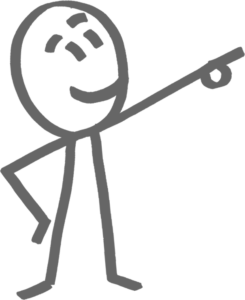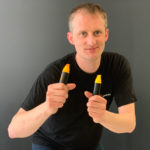









Founder of Coaching Tiger & All Lined Up
Jaya Machet has seen the world: She grew up in Mumbai, India and moved with her family to Switzerland when she was a teenager. She studied German and French before she joined Nokia Treasury in Geneva. More than 10 years ago she decided to move back to Asia and picked Singapore as her new home.
After all Jaya describes Singapore as the “the Switzerland of Asia”. Through her work at Nokia she got excited about executive coaching and graduated with a Masters of Counselling from the Monash University in 2010. She runs her own full time coaching business and recently discovered bikablo® and Neuland and added it to her portfolio. Today she is the local distributor for Neuland® facilitation gear in Singapore under the venture “All Lined Up.biz”.
Jaya introduces you to the topic of executive coaching. She explains what coaching is and isn’t by comparing it to deeper interventions like counselling and therapy. We introduce different coaching approaches and how they might be a fit for you. Jaya offers deep insights into executive coaching: Starting with the coaching contract and defining the objectives before we move on to practical tips & tricks you can use as a coach. We have a look at how bikablo® helps you to become a better coach and look into the future what bikablo® in Singapore might bring to the world going forward.
I have enjoyed the interview and the first bikablo® training in Singapore and look forward to be back for the next bikablo® training in September. Last but not least, if you live in USA, please check out our USA tour this summer.

Marcel combines agile team coaching with visual thinking. Marcel believes that a group of people drawing together on a whiteboard can change the world. He loves high-performing teams and therefore coaches teams every day.

Todays guest is Matthew Magain from sketchvideos.com.au. Matthew is a good friend of mine and I’ve been following his journey for quite a while. After Matthew gives us a bit of background of where he came from and how he started with sketch noting as a teacher in Japan we talk about sketch note videos in detail.
A lot of my students ask: “How can I create my own sketch note video” and I am very happy that Matthew opens his big draw of tricks and tips to share his insights with you.
We talk about your first setup and what is essential for a high quality recording. What the pre-production looks like and what steps you can take in the post-production to spice it up. We give an overview about digital tools on an iPad and what outcome you can expect from those tools.
After listening to the podcast you should have a good idea about how you can get started with your own sketch note video.
Please enjoy the interview with Matthew Magain from sketchvideos.com.au.

Marcel combines agile team coaching with visual thinking. Marcel believes that a group of people drawing together on a whiteboard can change the world. He loves high-performing teams and therefore coaches teams every day.



Co-Founder Brainmates
Today I talk to Nick Coster. Nick founded Brainmates together with his wife Adrienne Tan more then 12 year ago. Brainmates is one of those companies who are not very big but very professional. Their special field is product management. We talk about the evolution of product management. How the role of product management evolves when the organisation scales up and the CEO can’t be the product manager anymore.
Nick describes the role of a product manager as the chief storyteller in a company. The product manager is the CEO of a product but normally doesn’t have the same authority as the CEO. He needs to take everyone on the journey and explain the challenges ahead of the product. Storytelling is the key to this way of leadership and visual storytelling is the lasting version of it as you can capture the visualisation of the story in photos and videos. Therefore I am very excited to announce that we will run the bikablo® Visual Storytelling (bikablo Advanced) class in Australia shortly before Christmas.
Many of my bikablo® visual facilitation students are in a role around requirements gathering or are working in a business analyst role. In this interview, I put myself in the role of a business analyst and ask myself how could I become a great product manager. What does it take to become that person and what do I have to learn on the way.
Being on the product management journey alone can be quite challenging. It’s much better to go the way together and catch up with mates who are in a similar role as you. I would like to highlight the “Leading the Product Conference” run by Brainmates every year. The conference will be held this year on the 20th of October in Melbourne and 25th in Sydney. Check it out and I hope to see you around in one of the next bikablo® visualisation training.

Marcel combines agile team coaching with visual thinking. Marcel believes that a group of people drawing together on a whiteboard can change the world. He loves high-performing teams and therefore coaches teams every day.

Today I have the honour to bring to you Natalie Nelson. Natalie is the principal at Ashburton primary school. Her school never received much money since the 1920’s and were therefore entitled for a redevelopment. Natalie’s school received a big cheque which enabled her to bring the school to the next level of education.
Natalie tells her story of how she started on a journey to transform the school to a place of future education. Her approach is quite different to many others. She calls it design from the inside out. I give you an example what that means: After coming up with key principles what school should be about, they asked the children to create their new future school. You will learn why Ashburton primary has floor to ceiling windows or different learning areas for different students.
We talk about what it means to grow up in our complex world of today. What skills the kids need to learn which (by the way) are far beyond reading, writing and maths. Kids today need to learn how to keep their energy level in balance, how they can relax their mind and how to deal with complex problems in general. Those skills become much more valuable in the future. Today’s schools focus on deep thinking techniques because it is necessary for real creative work. You can outsource the process of writing but you can’t outsource the creativity. Through that we talk about the three levels of thinking and how to get down to the core thinking where the creative magic happens.
I think we all can do something about the future of our kid’s in the way they learn and even further in the way we all work together in our modern world. The insights from Ashburton primary school are not limited to school education at all, they are applicable to the way we work together in our offices as well.
So while you listen to this podcast think about who else would be inspired by the story and pass the ball on so that more people get in contact with the future of education. I hope you enjoy this episode with Natalie Nelson, principle at Ashburton primary school.
Finally, if the interview inspired you to improve your own creativity and visual thinking skills then you are welcome to come around to one of the bikablo® trainings. If you are in Europe jump over on bikablo.com and when you are in Australia or New Zealand have a look in the training section of my website and check out the training program there. Next one is coming up in Sydney, Melbourne and Perth and depending on when you book there might still be an early bird available. So jump over onto the website and book your next career step as a visual leader. Thanks again for listening – See you next time.

Marcel combines agile team coaching with visual thinking. Marcel believes that a group of people drawing together on a whiteboard can change the world. He loves high-performing teams and therefore coaches teams every day.



Design Thinking Trainer at LUMA Institute
Today I have the honour to have Patrick Sharbaugh with me. Patrick works for the LUMA institute, a training provider that enables companies and individuals to be more creative. He teaches design thinking and in this interview he gives us an introduction into the world of design thinking. We talk about creative problem solving, visual languages and what it means to have the customer in the centre of your solution design.
But first of all, let me introduce to you, Patrick. Patrick grew up in Charleston, South Carolina. He worked in Japan for a while and moved on to Vietnam where he worked in Saigon. In Saigon, he got in contact with the RMIT University and through that found his way to Australia. He works today in America as well as Australia as a trainer for Design Thinking, runs a Meet-up in the Melbourne CBD and is a great guy to meet every day.
We give you a step-by-step introduction into design thinking while we help Henry Ford to build a better car and explore why the Apple iPod 1 was important but not great.
I hope you enjoy this conversation with Patrick Sharbaugh from the LUMA Institute!

Marcel combines agile team coaching with visual thinking. Marcel believes that a group of people drawing together on a whiteboard can change the world. He loves high-performing teams and therefore coaches teams every day.



Founder of Chit Chat and Mosaic Lab
A couple of weeks ago I was running the first bikablo® visual facilitation garage. This advanced workshop has been around in Europe for a while and now we start this advanced class for people who have participated in the fundamentals class in Australia as well. When you start something new, you start something small and so Keith Greaves attended as the only attendee at the first visual facilitation garage in Melbourne in May.
Keith and I had a great time together working in the garage. We had 4 hours of intensive learning together and we both learnt from each other. So I thought we share our conversation over those four hours in an interview with you.
Let me introduce Keith Greaves in a couple of sentences. He grew up in Ireland and worked in several very interesting countries including Azerbaijan and Syria. Today Keith lives with this family in Melbourne running two companies: Chit Chat and Mosaic Lab.
Mosaic Lab is a company that facilitates big groups and creates spaces for c0-creating and collaboration. He sets up workshops for 80-300 people to bring people together from all parts of the societies and brings people together to collaborate. Keith puts a lot of this energy into preparing those venues and you will learn in this podcast how he does it.
What really hit me when listening to Keith was his passion for public participation following the core values of IAP2. He makes a difference in the world by improving our democracy. Our democracy is based on a the idea of a majority. A 50% majority is good but imagine you had a co-created law proposal for the prime minister that bases on a super majority of 80%.
Now let me pass on the microphone to Keith Greaves from MosaicLab listening to this story and I hope we see us at the next bikablo® visual facilitation garage in Melbourne!

Marcel combines agile team coaching with visual thinking. Marcel believes that a group of people drawing together on a whiteboard can change the world. He loves high-performing teams and therefore coaches teams every day.

In this episode I talk about the first day back at work where you need to find a way to apply the new skills in your day to day job. We talk about positive psychology and how you can motivate yourself to progress your visual journey every day in the office. Additional we introduce the visual facilitation garage. An advanced visual facilitation workshop where you can meet people who are on the same journey as you. This workshop will be help every month in Sydney and Melbourne and is hosted in Germany as well for many years. I hope you enjoy this short episode!
Hey! Guys, this is Marcel again from the Bikablo Radio with another insight episode.
Today I want to talk about the third day of the Bikablo training. If you have a look at the Bikablo training program in Australia you might say “There is no third day in the training”, and that’s right.
There is a two days training when you come to the Bikablo fundamentals and practitioner level, but what I mean is the third day, which is the first day when you’re back at work.
At work, the real change happens. You need to find ways to practice and apply the things you learnt on a daily basis. Here you might go through very mixed feelings.
First of all, you get a lot of positive feedback because people come to you and say Oh! My god, when have you learned to draw. I didn’t know that you could do that. That will actually happen, l promise you that, but as with everything new you also will not get it right the first time and you need to be OK with it.
What I mean is that you will not do the same performance you did in the training class. In the training room you had a safe environment and could explore the tools and techniques in your own speed. At work the speed of the others matter and outcomes become more important then the beauty of your lines. Very simple things that you had mastered in the training class are difficult again like drawing the light bulb or simple shapes like boxes and arrows.
Recently, I came across the work from Barbara Fredrickson, she is a scientist with more than twenty years experience in positive psychology. She wrote several books including Love 2.0 and Positivity.
On of her concepts which hit me and I really like is the “tipping point”. It is the ratio between positive and negative emotions and how to balance those feelings in a positive way: According to Barbara’s works, you need about three positive emotions to equalize one negative emotion.
That means for every line you draw not straight or every light bulb pictogram that looks a bit out of shape and funny, you need to celebrate three things that you did right and that you are happy about. The problem is when you tip over to the negative side you are more likely to stop the change you started in the training and through that you would have wasted time and training budget.
So how can you make sure that you get a healthy ratio between your positive emotions so that it equalizes the negative emotions out which will appear most definitely.
First, you celebrate everything that you got right and through that motivate yourself. That could mean that you are proud about your neat writing or the bikablo® containers and frames you swapped your content in. Or the strategic use of colours and the way you applied the shadows and highlights – every little success counts towards the positive emotions ratio. Please open your eyes and celebrate those little successes at work every day.
Secondly, I would like to introduce to you another great concept of Barbara Fredrickson work where she describes “micro moments of connections” between people. Those are the beautiful moments when two people see each other. It’s when you understand each others needs and feel connected with someone.
Of course you need a person you trust and can be open to. It’s a person that has a smile always ready for you at work. In our corporate world we need those good mates so that we can support each other every day. When starting visual facilitation you reactivate your drawing skill that you had almost forgotten since childhood and you need good mates that give you constructive feedback to progress further.
However, even if you have great people at work it is very hard for them to offer feedback to you as you probably do something new they have no own experience in. Therefore they struggle to support you even if they would like it.
Here the bikablo® Akademie will not let you down, we present to you the new bikablo® Visual Facilitation Garage. An advanced half-day bikablo® workshop in Sydney and Melbourne that brings together bikablo® graduates to practice, learn and grow together as visual leaders. If you are in German speaking Europe – The visual facilitation garage is also hosted in Germany.
You will get feedback about your work and see what you have already mastered and where you need to improve next. You will learn from someone who is on the same journey as you or just a couple of steps ahead!
I hope that the bikablo® Visual Facilitation Garage can provide you not only with necessary feedback but also creates those awesome “micro-moments of connection” that everyone need to reenergize their batteries so that you stay on track and become a visual ninja at work.
I hope to see you soon in Melbourne or Sydney in the Visual Facilitation Garage. Thank you very much and have a great week.

Marcel combines agile team coaching with visual thinking. Marcel believes that a group of people drawing together on a whiteboard can change the world. He loves high-performing teams and therefore coaches teams every day.



Agile Coach for AGL
I don’t know about you but I see many companies who put a lot of whiteboards inside their offices and I am not sure yet that they know how to make the best use of them.
Today’s guest is Christiane Anderson, she works as an Agile Coach for AGL. AGL is one of the major energy providers in Australia. AGL was founded in 1837 and was the company that lid the first gas lamp in Australia in 1841. Today they are listed as one of top 50 companies on the Australian Stock Exchange (ASX).
This episode is about Christiane’s journey from discovering the bikablo® drawing technique. We look at how she started small by showing the value of visual facilitation to AGL before it took off and inspired others through the whole organisation.
Additionally, we talk about visual facilitation in the context of an agile business transformation and what changes are needed in the human behaviours when working in an agile environment. We explore how agile coaching and life coaching can help each individual in the company to come along on an agile journey.
We provide you with a couple of tips about how you can light a fire of change and lead it in your organisation. This episode is about how you can start small and become bold.
I hope you enjoy this conversation with Christiane from AGL.

Marcel combines agile team coaching with visual thinking. Marcel believes that a group of people drawing together on a whiteboard can change the world. He loves high-performing teams and therefore coaches teams every day.

Attending the bikablo® visual facilitation training is only 50% of the deal. You need to apply it and keep practising on your day-to-day job. One of the best ways to improve your visual facilitation skills is by learning from each other in a community of practise. In this short episode I talk about different communities of practise I have been part of in my career and would like to invite you to join the bikablo® graduates group on LinkedIn.
I would like to ask you a question. Are you part of a community of practice? Now, you might wonder, what is he talking about? Okay, let’s look into the words step-by-step and see what a community of practice means.
Are you part of a community? You’re part of a country, which is already a community. You’re part of a family, and you may be part of a work environment.
All those are communities. However, you might not think of it as a place where you learn from each other new techniques, tools or crafts because most communities are diverse and share little in common.
This is different in the community of practice. A community of practice, you meet like-minded people who want to learn the same thing in life and therefore exchange their experience.
You look for people who have achieved something you try to master right now and they act as a mentor for you. At the same time you become a leader for others. This creates a network of people learning and growing together their skill set.
Let me give you an example of a community of practice I was part of. When I first heard about the extreme programming, I was very excited to figure out what this agile approach of delivering software would mean and how I could apply it to my world.
I looked into the extreme programming (XP) community by following online discussions, attending user groups to meet like-minded people. That helped me to explore this new topic I had heart about in the podcast. I learnt from other and probably asked every question you can ask twice.
Same again when I got into visual facilitation. I discovered visual facilitation as an awesome way to interact and collaborate with people. It helps to convey my message across to the people I work with every day.
However, in the beginning it was not the easiest thing to start drawing live on a white board while people looking at your drawing and spelling mistakes. So hearing from other graphic recorders and visual facilitators about their journey helped me to learn and grow.
So why is a community of practice so important? For me this all comes back to our human needs. Let’s have a look at the Maslow’s Hierarchy of Needs. The fundament of that step ladder is safety and the fulfilment of your physiological needs. Like food and shelter. I am quite confident that you have reached that level by the pure fact that you have conditions in life that enable you to listen to this podcast. If you would worry about food and shelter you probably would not have the capacity to think about this podcast.
The next level in the Hierarchy of Needs is love and belonging. Communities of practise help at this point because it provides a group of people who like to do the same things you like and everyone shares their experience. You notice that your challenges are not so different from others and that someone found a solution for your problem already.
Level up on Maslow’s ladder again and we talk about esteem or acknowledgement by others. Esteem gives you the feeling that you are on the right track. I often come home from Meetups and have the feeling that I do well and should progress my path. I also feel good because I could help others on their journey. Some people need more acknowledgement some people less. However, most people need a bit of the good feeling and the comfort that we are on the right track.
The final step in that hierarchy is the self-actualisation. Self-actualization is a tricky one. Some people say they just know what they should do in life and feel like they are called to do it. However for me this is not so clear – I enjoy learning new things and passing them on. For many it is the quest about what you want to do with your life and who you would like to become.
So why am I telling you that? First of all, I believe that coming to my bikablo® visual facilitation training is only 50% of your job. You need to find your community of practise, simply to keep practising and learning from others. If you are from Melbourne or Sydney we have Meetups around visual facilitation. The Melbourne Meetup is hosted by me and you are welcome to learn about visual facilitation even if you haven’t participated in a bikablo® training.”
However, there is more. I’m very proud to present to you a new bikablo® community of practise. It is a closed network for bikablo® graduates that are now practising their visual thinking and facilitation skills on their day-to-day job. The group is hosted on Linkedin and every training attendee from the past got invited.
I believe that those communities are even stronger because you already made some commitment by coming to a bikablo® training. This online community of practice is a community where you find people that are one the same journey. They might have been in the training two-month earlier but we are on the same journey together. On top of that you can ask questions to other bikablo® trainers who hang out with you. The beauty is that each trainer is different. I apply bikablo® is the world of agile coaching and culture change but we have trainers who use bikablo® for process mapping, business consulting or counselling. All bikablo® trainers together have more than 150 years of visual facilitation experience.
If you have participated in a bikablo® training in Europe, Australia or Asia. Please accept my invite to the bikablo® graduates community. If you haven’t been to a bikablo® training just follow the link below and join the bikablo® community of practise tomorrow.
Please remember that the training is just the kick-start. You need to keep the engine running and learn on daily bases.
Thank you very much for listening to bikablo® insight, and I hope to see you in one of the trainings in Sydney, Melbourne or anywhere in Europe.

Marcel combines agile team coaching with visual thinking. Marcel believes that a group of people drawing together on a whiteboard can change the world. He loves high-performing teams and therefore coaches teams every day.



Helping others is natural to us but asking for help is sometimes difficult to many. The reason behind lays in the way we grew up, how we were raised and not at last in a school system that was focused on competition and performance not on collaboration and creative thinking. However, todays challenges in business lay in the ability to solve complex problems together as a team and for me one of the most important steps to become a strong team is to overcome the fear of asking for help and embrace the fact that nobody is perfect. Through that asking for help becomes a personal strength. Remember todays problems are just too complex for one brain anyway.
In this insight episode I walk you through a scenario how you can offer help as a visual leader. You don’t have to be the subject matter expert – just a good listener with a pen using a whiteboard. Often it is enough that the person who has the problem steps out of the problem space for a moment and explains the challenge to someone else. I explain you my 8-steps to help him/her to unblock any problem solving. By following the 8-steps you have a chance to engage even more people of your team in the solution design and through that improve your team and company culture on the long run. These steps are not always strictly followed, they shall be a guide to get started as a visual leader on a whiteboard.
I hope you enjoy this episode! Please share it in your network if it is useful for you.

Marcel combines agile team coaching with visual thinking. Marcel believes that a group of people drawing together on a whiteboard can change the world. He loves high-performing teams and therefore coaches teams every day.

